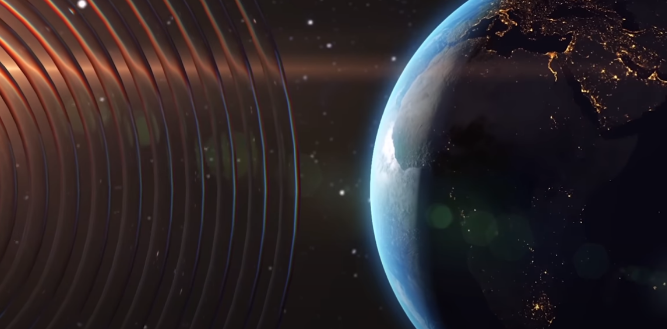Quasars are one of the most powerful stars in the universe, which I believe no one would object to. There is no exception in the interior of a galaxy, there is one or more quasars sitting, perhaps no one can imagine that one day, such terrible stars will meet and even collide to produce a shocking explosion!
Yes, you read that right, scientists have observed an unusually powerful "bomb" in the universe ticking away somewhere in deep space, and it will undoubtedly explode. A collision between two quasars would trigger a terrifying shockwave with the force of millions of SUNS that would shake the fabric of our universe and sweep across Earth on a cosmic scale, so would Earth be in danger?
In fact, astronomers only recently discovered this quasar bomb, though they've been looking directly at it for a long time, and only now are they able to confirm it. The first such objects discovered in the 1950s were powerful radio beacons in places where there seemed to be no stars around. At the time, these objects were known as quasi-stellar radio sources, or simply quasars 39bet-kết quả bóng đá-kết quả xổ số miền bắc-kèo bóng đá -soi cầu bóng đá-đặt cược. Until researchers discovered these incredibly bright quasars, which shoot deadly X-rays and gamma rays at telescopes.
The problem is, some quasars only give us a sideways view. That's why we can only detect faint radio waves from their heated accretion platform. Meanwhile, we observe other quasars, as seen from above, whose poles and powerful exhaust jets emit X-rays and gamma rays directed at us. Then a quasar explodes in the galactic core, and our planet's ozone layer will be done for good, at worst waving goodbye to all life on its surface.
 Fortunately, this particular unnamed quasar is very far away, 9 billion light years away, and scientists have been observing it for as long as 30 years. Until 2021, they realized that they spent decades of time staring at what turned out to be a huge time bombs, the time bomb is different from any other ordinary time bomb, it is not stable beacon, because quasars consuming material quantity is not equal, so they are like a flashing neon lights flashing instability, But the light generated by this time bomb lies 9 billion years away, ticking away each year, like a guardian feeding it on a specific schedule.
Fortunately, this particular unnamed quasar is very far away, 9 billion light years away, and scientists have been observing it for as long as 30 years. Until 2021, they realized that they spent decades of time staring at what turned out to be a huge time bombs, the time bomb is different from any other ordinary time bomb, it is not stable beacon, because quasars consuming material quantity is not equal, so they are like a flashing neon lights flashing instability, But the light generated by this time bomb lies 9 billion years away, ticking away each year, like a guardian feeding it on a specific schedule.
In the universe, only pulsars can maintain such precise periods, but their periods are measured in fractions of a second. Moreover, they appear because of tiny neutron stars, not supermassive black holes. As for quasars, quasars are the most distant and energetic active galactic nuclei from Earth, so you can think of them like black holes. So far, these are the only pair of quasars known to science.
Scientists, according to preliminary estimates, if put the quasar system on the top of our solar system, center quasars are most likely to reach the orbit of Mars and the other a quasar will eventually reach the boundary of the oort cloud. This means that about 2000 astronomical units of distance, looks very far, but is very close on cosmic scales. And crucially, scientists calculate that they are getting closer, starting about 100 years ago. So once this kind of galaxy explodes, does it affect Earth?
Before that, scientists had observed a collision between two black holes affecting the entire universe. In September 2015, scientists discovered gravitational waves triggered by the merger of two black holes, each weighing 30 times the mass of the sun. When they hit each other, about three solar masses are released as part of the energy in the gravitational shock wave, which passes through the Earth and all of us at the speed of light, but we don't feel anything unusual. This is because explosions are weak, so space expands and contracts on a much smaller scale than atoms.
But this time, the collision between the black holes of the quasar bomb will create shockwaves of unprecedented strength, gravitational waves with the energy of about 10 million SUNS, and we may suffer the pain of separation at the atomic level. Among other things, maybe it could temporarily stop nuclear reactions in the sun, or break the bonds between atoms and break our planet apart. So far, the gravitational waves detected by scientists are millions of times weaker than before, so no one can definitively answer these questions. Scientists have yet to calculate the exact mass of the quasar bombs and find the weak gravitational waves they generate as they approach.
The only thing astronomers know for sure right now is that the quasar bomb will explode in 10,000 years, given the timescales of our universe. If the quasar is 9 billion light years from Earth, that means the two black holes collided long before our solar system and parent star were born. If so, a shockwave of gravitational effects from a quasar explosion is hurtling through the Milky Way, just 10,000 light-years away. Do you think the Earth will still exist in 10,000 years? Feel free to leave your comments!